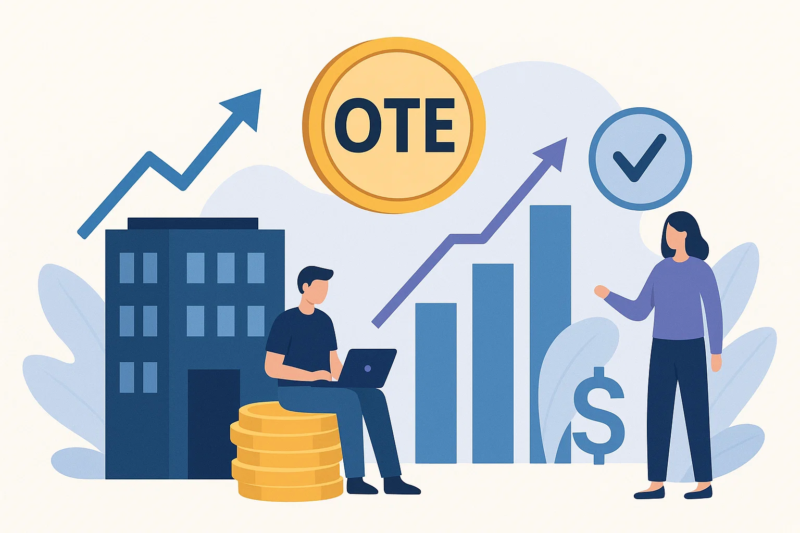
On-target earnings is a compensation term used most often in sales. OTE is the sum of a fixed base salary and a set variable or commission amount, assuming the employee meets specific performance targets within a year. A job posted as offering “$100,000 OTE” could mean $60,000 as a base salary and $40,000 in commission if targets are achieved. OTE does not include bonuses, stock, or extras often used as perks.
OTE gives structure to compensation plans. It forms the basis for planning and forecasting payroll. The arrangement links company performance goals with individual pay in a clear way. In most industries using OTE, technology, business services, healthcare sales, and others, commission is only earned if the employee hits or exceeds approved targets.
The calculation is as follows:
For example, if a rep has a $95,000 base and is told they can earn another $95,000 by hitting quotas, their OTE is $190,000 per year. Complexity appears in multi-layered commission plans, where different products, deal sizes, or regions have unique percentages.
Table of Contents

Offering OTE can strengthen hiring. Over three-quarters of applicants in sales fields list OTE transparency as a top deciding factor when picking an employer. Using structured OTE plans lets companies manage payroll costs more easily because commissions are capped on quota rather than unlimited. For organizations, predictable compensation reduces budget surprises and links spend with productivity.
OTE can also drive results. A medical sales company increased revenue by over 20% after it changed its model to make OTE more prominent and aligned quotas with real market data. These strategies often help firms retain talent because employees see a clear path to higher pay through performance.
Workers say OTE motivates them because it removes guesswork. Nearly nine out of ten sales professionals prefer this setup over straight salary. They want to know how much they can earn if they do what’s asked. Sales staff and recruiters agree: clear targets help higher performers plan their income and careers.
Uncapped OTE, which allows earnings over 100% quota, is popular but carries risk. Top salespeople may prefer this, but new hires may find it risky if quotas are set too high or the company’s products are hard to sell. A mix of capped and uncapped structures appears in tech and service fields.

A business software provider set its sales OTE as $120,000 base and $30,000 target commission for account executives. By aligning commission with long-term subscription deals instead of one-time sales, annual contract values went up 35% in under two years, and rep turnover went down.
A device manufacturer switched to a 70/30 OTE model. The incentive tied commission not to orders, but to post-sale metrics, such as new user onboarding and product training session completions. This led to better customer feedback and kept support scores high, resulting in more repeat orders.
A national retailer offered a capped OTE model to its field sales force, matching a $50,000 base with $22,000 commission potential. Cost control improved, but some top reps left for roles with higher or uncapped potential, showing the effect OTE structure can have on staff retention.
Although public case studies on named brands are rare, compensation data from Salesforce and Outreach.io show that leading firms in software and cloud solutions heavily use OTE models to attract and retain top performers.

Companies should study current market pay rates and tailor OTE structures accordingly. For example, in 2023, OTE averages in enterprise software rose by 12% as firms fought for limited sales talent. Regular reviews of quota set realistic performance goals. A reported 58% of sales staff say they miss OTE payouts if quotas are unclear or impossible to reach. Clear communication at hiring helped some organizations improve applicant-to-hire ratios by 30% within a year.
Sales professionals should clarify compensation plan details and check for hidden rules or “recoverable draws” that could affect take-home pay. When discussing OTE in interviews, the best performers reference their track records to ask for higher base or OTE totals. Staff who track their deals and quotas with smart tools see better results and more regular OTE payouts.

Recent years have seen OTE debated on business platforms. LinkedIn users discuss the need for higher OTE and more achievable quotas in the face of inflation and market uncertainty. On forums, sales workers compare their OTE across regions, noting gaps between U.S. and EU markets due in part to different tax rules. Social analytics services note a growing group of job seekers who filter positions only by clear OTE figures, especially in tech and business services.
Uncapped OTE remains a hot topic. Some predict that companies overemphasizing variable pay face higher turnover rates during economic downturns—up to 45% in sectors with more than 80% of compensation tied to sales performance. More businesses are experimenting with quarterly reviews and variable OTE tied to fast-moving products or industries, but many find that too much variability can create confusion.
OTE brings structure and clear expectations to pay plans in performance-driven roles. For leaders, it helps attract and keep high-quality sales talent while keeping payroll predictable. For professionals, it offers a direct line of sight between what they earn and what they achieve. Data from the past five years shows OTE models spreading into more fields and evolving with new business priorities. Companies succeed when they tailor OTE and quotas to both market conditions and realistic performance expectations. The main lesson remains: both sides need clarity, fairness, and a plan grounded in real data, not guesswork.
Fred Metterhausen is a Chicago based computer programmer, and product owner of the current version of Maptive. He has over 15 years of experience developing mapping applications as a freelance developer, including 12 with Maptive. He has seen how thousands of companies have used mapping to optimize various aspects of their workflow.
